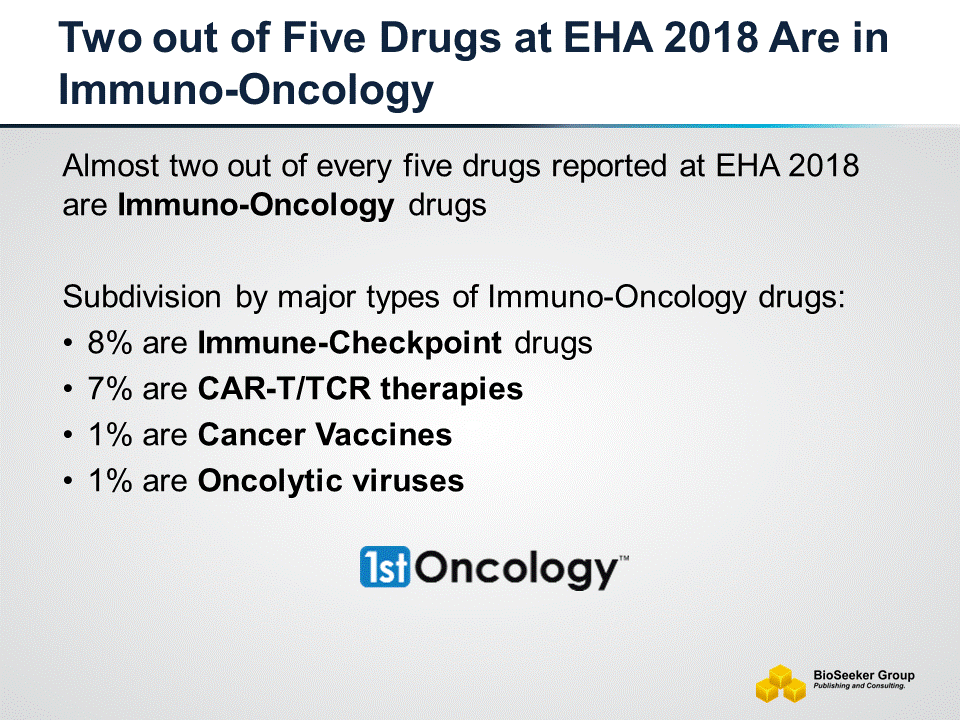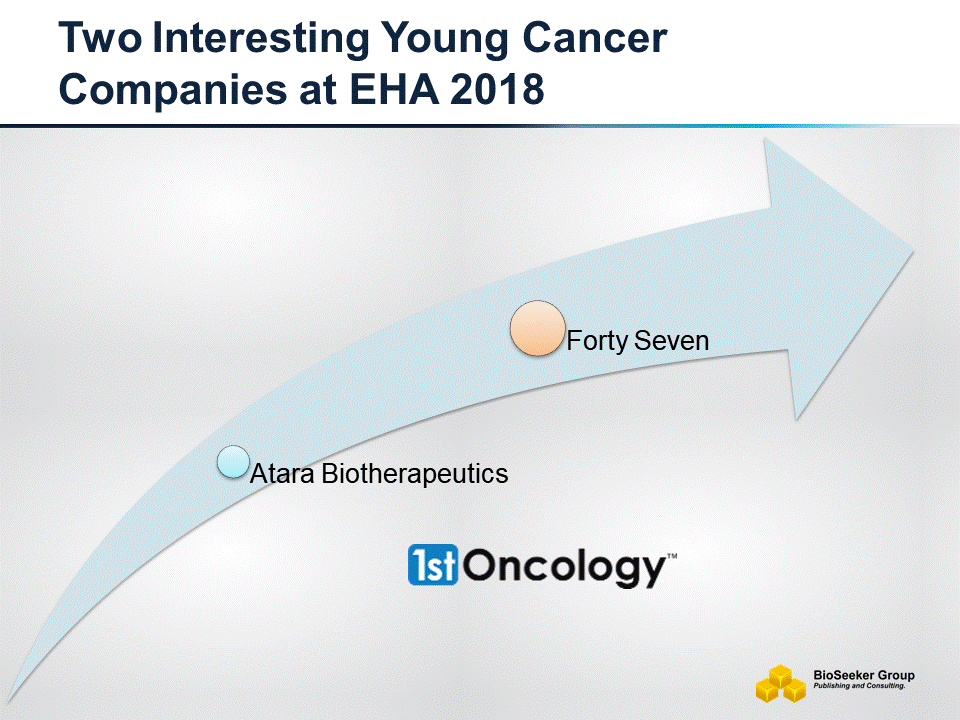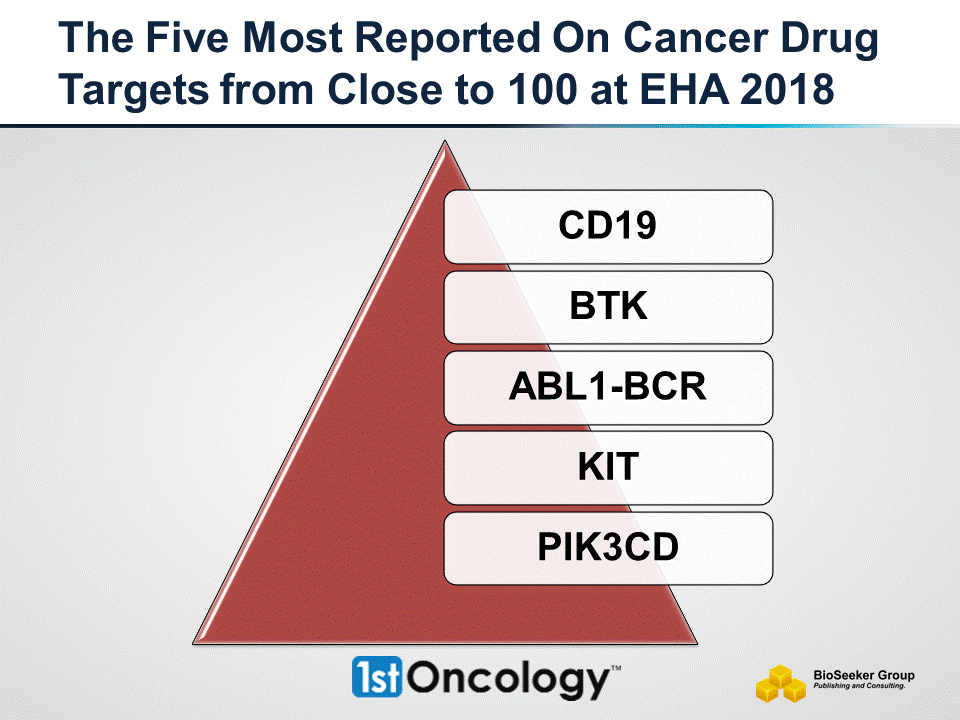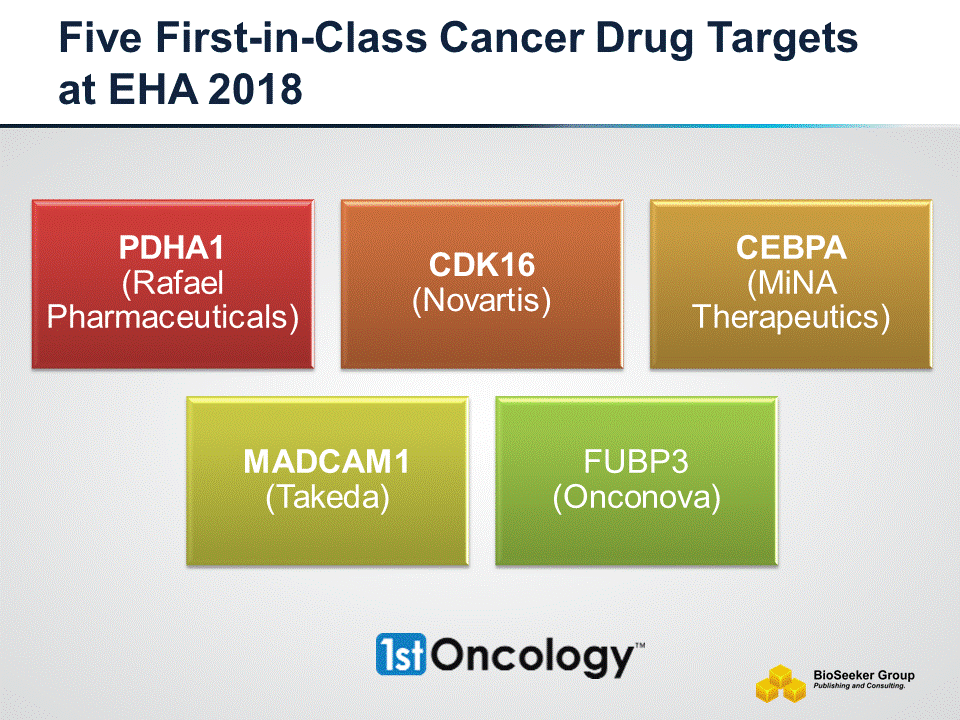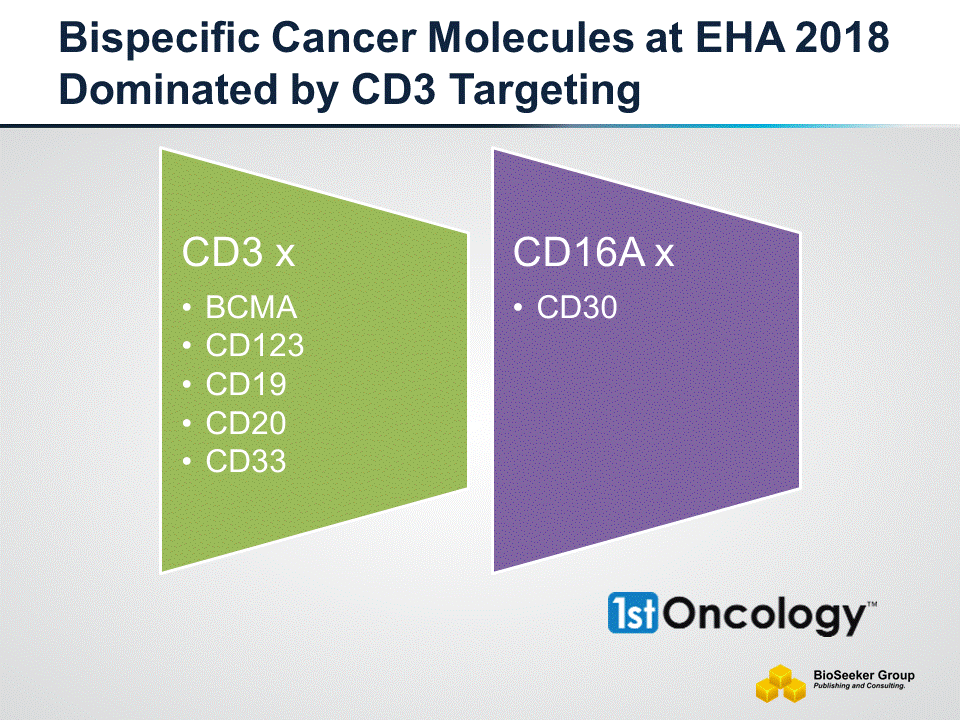On June 19, 2018 Amgen (NASDAQ:AMGN) reported that the European Commission (EC) has granted a full marketing authorization for BLINCYTO (blinatumomab) based on the overall survival (OS) data from the Phase 3 TOWER study in adult patients with Philadelphia chromosome-negative (Ph-) relapsed or refractory B-cell precursor acute lymphoblastic leukemia (ALL) (Press release, Amgen, JUN 19, 2018, View Source;p=RssLanding&cat=news&id=2355141 [SID1234527392]).
Schedule your 30 min Free 1stOncology Demo!
Discover why more than 1,500 members use 1stOncology™ to excel in:
Early/Late Stage Pipeline Development - Target Scouting - Clinical Biomarkers - Indication Selection & Expansion - BD&L Contacts - Conference Reports - Combinatorial Drug Settings - Companion Diagnostics - Drug Repositioning - First-in-class Analysis - Competitive Analysis - Deals & Licensing
Schedule Your 30 min Free Demo!
"BLINCYTO is the first single agent immunotherapy to demonstrate superior overall survival benefit over standard of care," said David M. Reese, M.D., senior vice president of Translational Sciences and Oncology at Amgen. "For decades, overall survival has been the gold standard for assessing the efficacy of treatments for blood cancers. The near doubling of median overall survival versus standard of care seen in the TOWER study is groundbreaking and reinforces BLINCYTO as a highly effective ALL therapy, providing physicians with a much needed, efficacious treatment option, potentially offering patients the chance to live longer."
BLINCYTO is the first-and-only bispecific CD19-directed CD3 T cell engager (BiTE) immunotherapy construct approved globally. It is also the first bispecific immunotherapy from Amgen’s BiTE platform, an innovative approach that helps the body’s immune system target cancer cells.
In the TOWER study, BLINCYTO demonstrated a superior improvement in median OS over standard of care (SOC) chemotherapy. Median OS was 7.7 months (95 percent CI: 5.6, 9.6) for BLINCYTO versus four months (95 percent CI: 2.9, 5.3) for SOC (HR for death=0.71; p=0.012). For patients treated in first salvage, the median OS was 11.1 months for BLINCYTO versus 5.3 months for SOC (HR=0.6, 95 percent CI: 0.39, 0.91). Safety results among subjects who received BLINCYTO were comparable to those seen in the previous Phase 2 studies of BLINCYTO in adult patients with Ph- relapsed or refractory B-cell precursor ALL.
Approval via the centralized procedure allows for obtaining a marketing authorization from the EC, which is valid in all European Union (EU) and European Economic Area (EEA)-European Free Trade Association (EFTA) states (Norway, Iceland and Liechtenstein).
About TOWER
The TOWER study was a Phase 3, randomized, active-controlled, open-label study investigating the efficacy of BLINCYTO versus SOC chemotherapy in 405 adult patients with Ph- relapsed or refractory B-cell precursor ALL. The study enrolled a difficult-to-treat patient population which included patients at several states of relapse. In the BLINCYTO arm, this included 35 percent of patients that had relapsed post-allogenic hematopoietic stem cell transplant (alloHSCT), and excluded those with late first relapse (≥12 months after initial remission). Patients were randomized in a 2:1 ratio to receive BLINCYTO (n=271) or treatment with investigator choice of SOC chemotherapy (n=134). The determination of efficacy was based on OS. Per the recommendation of an independent data monitoring committee, Amgen ended the study early for evidence of superior efficacy in the BLINCYTO arm versus SOC chemotherapy. These results were published in The New England Journal of Medicine.
About Adult ALL in Europe
ALL is a rare and rapidly progressing cancer of the blood and bone marrow.1,2 The incidence of adult ALL in European countries is generally between 0.6 to 0.9 per 100,000 persons per year.3 In adult ALL, approximately 75 percent is B-cell precursor ALL, of which 75-80 percent is Ph- and roughly half will be refractory to treatment or experience relapse.3 Thus, with a population projection of 416 million adults in the EU,4 it is estimated that the incidence of adult Ph- relapsed or refractory B-cell precursor ALL in the EU is approximately 900 patients per year.5
About BLINCYTO (blinatumomab)
BLINCYTO is a bispecific CD19-directed CD3 T cell engager (BiTE) immunotherapy construct that binds specifically to CD19 expressed on the surface of cells of B-lineage origin and CD3 expressed on the surface of effector T cells. BLINCYTO was granted breakthrough therapy and priority review designations by the FDA in 2014, and carries full approval in the U.S. for the treatment of relapsed or refractory B-cell precursor ALL in adults and children. In the U.S., BLINCYTO is also approved under accelerated approval for the treatment of adults and children with B-cell precursor ALL in first or second complete remission with minimal residual disease (MRD) greater than or equal to 0.1 percent. This indication is approved under accelerated approval based on MRD response rate and hematological relapse-free survival (RFS). Continued approval for this indication may be contingent upon verification and description of clinical benefit in the confirmatory trials.
In 2015, BLINCYTO was granted conditional marketing authorization in the EU for the treatment of adults with Ph- relapsed or refractory B-cell precursor ALL.
About BiTE Technology
Bispecific T cell engager (BiTE) antibody constructs are a novel immuno-oncology technology that can theoretically be engineered to target any surface antigen expressed by any type of cancer. The modified antibodies are designed to kill malignant cells using the patient’s own immune system, by bridging T cells to tumor cells. BiTE antibody constructs connect the T cells to the targeted cell, with the intent of allowing T cells to inject toxins which trigger cancer cell death (apoptosis). Amgen is developing BiTE antibody constructs to uniquely target numerous hematologic malignancies and solid tumors.
Important EU BLINCYTO (blinatumomab) Safety Information
This product is subject to additional monitoring in the EU. All suspected adverse reactions should be reported in accordance with the national reporting system.
The adverse reactions described in this section were identified in the randomized Phase 3 clinical trial (n=267) and in the single-arm Phase 2 study (n=189) in adults with Ph- relapsed or refractory B-precursor ALL who received BLINCYTO. The most serious adverse reactions that may occur during blinatumomab treatment include: infections (29.6%), neutropenia/febrile neutropenia (11.6%), neurologic events (11.6%), cytokine release syndrome (2.4%), and tumour lysis syndrome (0.9%). The most common adverse reactions were: infections (63.6%), pyrexia (60.1%), infusion-related reactions (32.0%), headache (31.1%), febrile neutropenia (25.7%), anaemia (24.8%), oedema (24.1%), neutropenia (22.1%), thrombocytopenia (20.4%), increased liver enzymes (16.7%), cough (16.2%), and rash (16.0%).
Please refer to the Summary of Product Characteristics for full European prescribing information.
Important Safety Information Regarding BLINCYTO (blinatumomab) U.S. Indication
WARNING: CYTOKINE RELEASE SYNDROME and NEUROLOGICAL TOXICITIES
Cytokine Release Syndrome (CRS), which may be life-threatening or fatal, occurred in patients receiving BLINCYTO. Interrupt or discontinue BLINCYTO as recommended.
Neurological toxicities, which may be severe, life-threatening or fatal, occurred in patients receiving BLINCYTO. Interrupt or discontinue BLINCYTO as recommended.
Contraindications
BLINCYTO is contraindicated in patients with a known hypersensitivity to blinatumomab or to any component of the product formulation.
Warnings and Precautions
Cytokine Release Syndrome (CRS): CRS, which may be life-threatening or fatal, occurred in patients receiving BLINCYTO. The median time to onset of CRS is 2 days after the start of infusion. Closely monitor patients for signs and symptoms of serious adverse events such as fever, headache, nausea, asthenia, hypotension, increased alanine aminotransferase (ALT), increased aspartate aminotransferase (AST), increased total bilirubin (TBILI), and disseminated intravascular coagulation (DIC). The manifestations of CRS after treatment with BLINCYTO overlap with those of infusion reactions, capillary leak syndrome (CLS), and hemophagocytic histiocytosis/macrophage activation syndrome (MAS). In clinical trials of BLINCYTO, CRS was reported in 15% of patients with relapsed or refractory ALL and in 7% of patients with MRD-positive ALL. Interrupt or discontinue BLINCYTO as outlined in the PI.
Neurological Toxicities: Approximately 65% of patients receiving BLINCYTO in clinical trials experienced neurological toxicities. The median time to the first event was within the first 2 weeks of BLINCYTO treatment and the majority of events resolved. The most common (≥ 10%) manifestations of neurological toxicity were headache and tremor. Severe, life‐threatening, or fatal neurological toxicities occurred in approximately 13% of patients, including encephalopathy, convulsions, speech disorders, disturbances in consciousness, confusion and disorientation, and coordination and balance disorders. Manifestations of neurological toxicity included cranial nerve disorders. Monitor patients for signs or symptoms and interrupt or discontinue BLINCYTO as outlined in the PI.
Infections: Approximately 25% of patients receiving BLINCYTO in clinical trials experienced serious infections such as sepsis, pneumonia, bacteremia, opportunistic infections, and catheter-site infections, some of which were life-threatening or fatal. Administer prophylactic antibiotics and employ surveillance testing as appropriate during treatment. Monitor patients for signs or symptoms of infection and treat appropriately, including interruption or discontinuation of BLINCYTO as needed.
Tumor Lysis Syndrome (TLS), which may be life-threatening or fatal, has been observed. Preventive measures, including pretreatment nontoxic cytoreduction and on-treatment hydration, should be used during BLINCYTO treatment. Monitor patients for signs and symptoms of TLS and interrupt or discontinue BLINCYTO as needed to manage these events.
Neutropenia and Febrile Neutropenia, including life-threatening cases, have been observed. Monitor appropriate laboratory parameters (including, but not limited to, white blood cell count and absolute neutrophil count) during BLINCYTO infusion and interrupt BLINCYTO if prolonged neutropenia occurs.
Effects on Ability to Drive and Use Machines: Due to the possibility of neurological events, including seizures, patients receiving BLINCYTO are at risk for loss of consciousness, and should be advised against driving and engaging in hazardous occupations or activities such as operating heavy or potentially dangerous machinery while BLINCYTO is being administered.
Elevated Liver Enzymes: Transient elevations in liver enzymes have been associated with BLINCYTO treatment with a median time to onset of 3 days. In patients receiving BLINCYTO, although the majority of these events were observed in the setting of CRS, some cases of elevated liver enzymes were observed outside the setting of CRS, with a median time to onset of 19 days. Grade 3 or greater elevations in liver enzymes occurred in approximately 7% of patients outside the setting of CRS and resulted in treatment discontinuation in less than 1% of patients. Monitor ALT, AST, gamma-glutamyl transferase (GGT), and TBILI prior to the start of and during BLINCYTO treatment. BLINCYTO treatment should be interrupted if transaminases rise to > 5 times the upper limit of normal (ULN) or if TBILI rises to > 3 times ULN.
Pancreatitis: Fatal pancreatitis has been reported in patients receiving BLINCYTO in combination with dexamethasone in clinical trials and the post-marketing setting. Evaluate patients who develop signs and symptoms of pancreatitis and interrupt or discontinue BLINCYTO and dexamethasone as needed.
Leukoencephalopathy: Although the clinical significance is unknown, cranial magnetic resonance imaging (MRI) changes showing leukoencephalopathy have been observed in patients receiving BLINCYTO, especially in patients previously treated with cranial irradiation and antileukemic chemotherapy.
Preparation and administration errors have occurred with BLINCYTO treatment. Follow instructions for preparation (including admixing) and administration in the PI strictly to minimize medication errors (including underdose and overdose).
Immunization: Vaccination with live virus vaccines is not recommended for at least 2 weeks prior to the start of BLINCYTO treatment, during treatment, and until immune recovery following last cycle of BLINCYTO.
Risk of Serious Adverse Reactions in Pediatric Patients due to Benzyl Alcohol Preservative: Serious and fatal adverse reactions including "gasping syndrome," which is characterized by central nervous system depression, metabolic acidosis, and gasping respirations, can occur in neonates and infants treated with benzyl alcohol-preserved drugs including BLINCYTO (with preservative). When prescribing BLINCYTO (with preservative) for pediatric patients, consider the combined daily metabolic load of benzyl alcohol from all sources including BLINCYTO (with preservative) and other drugs containing benzyl alcohol. The minimum amount of benzyl alcohol at which serious adverse reactions may occur is not known. Due to the addition of bacteriostatic saline, 7-day bags of BLINCYTO solution for infusion with preservative contain benzyl alcohol and are not recommended for use in any patients weighing < 22 kg.
Adverse Reactions
The most common adverse reactions (≥ 20%) in clinical trial experience of patients with MRD-positive B-cell precursor ALL (BLAST Study) treated with BLINCYTO were pyrexia, infusion related reactions, headache, infections (pathogen unspecified), tremor, and chills. Serious adverse reactions were reported in 61% of patients. The most common serious adverse reactions (≥ 2%) included pyrexia, tremor, encephalopathy, aphasia, lymphopenia, neutropenia, overdose, device related infection, seizure, and staphylococcal infection.
The most common adverse reactions (≥ 20%) in clinical trial experience of patients with Philadelphia chromosome-negative relapsed or refractory B-cell precursor ALL (TOWER Study) treated with BLINCYTO were infections (bacterial and pathogen unspecified), pyrexia, headache, infusion-related reactions, anemia, febrile neutropenia, thrombocytopenia, and neutropenia. Serious adverse reactions were reported in 62% of patients. The most common serious adverse reactions (≥ 2%) included febrile neutropenia, pyrexia, sepsis, pneumonia, overdose, septic shock, CRS, bacterial sepsis, device related infection, and bacteremia.
Adverse reactions that were observed more frequently (≥ 10%) in the pediatric population compared to the adult population were pyrexia (80% vs. 61%), hypertension (26% vs. 8%), anemia (41% vs. 24%), infusion-related reaction (49% vs. 34%), thrombocytopenia (34% vs. 21%), leukopenia (24% vs. 11%), and weight increased (17% vs. 6%).
In pediatric patients less than 2 years old (infants), the incidence of neurologic toxicities was not significantly different than for the other age groups, but its manifestations were different; the only event terms reported were agitation, headache, insomnia, somnolence, and irritability. Infants also had an increased incidence of hypokalemia (50%) compared to other pediatric age cohorts (15-20%) or adults (17%).
Dosage and Administration Guidelines
BLINCYTO is administered as a continuous intravenous infusion at a constant flow rate using an infusion pump which should be programmable, lockable, non-elastomeric, and have an alarm.
It is very important that the instructions for preparation (including admixing) and administration provided in the full Prescribing Information are strictly followed to minimize medication errors (including underdose and overdose).
Please see full Prescribing Information, including Boxed WARNINGS and Medication Guide, for BLINCYTO.
About Amgen’s Commitment to Oncology
Amgen Oncology is committed to helping patients take on some of the toughest cancers, such as those that have been resistant to drugs, those that progress rapidly through the body and those where limited treatment options exist. Amgen’s supportive care treatments help patients combat certain side effects of strong chemotherapy, and our targeted medicines and immunotherapies focus on more than a dozen different malignancies, ranging from blood cancers to solid tumors. With decades of experience providing therapies for cancer patients, Amgen continues to grow its portfolio of innovative and biosimilar oncology medicines.
